Who gets to play what parts? The film industry has many roles that make us ask: was this really the best choice for this role? Writer-director Aaron Schimberg’s latest film, A Different Man, looks at these questions through a very dark and absurd comedy, with elements of body horror.
It feels almost as if Charlie Kaufman tried to remake The Fly. A Different Man is very uncomfortable and constantly asks questions, proving to be a bold film that does not go down easily.
What Is A Different Man About?
Sebastian Stan plays Edward, an aspiring actor who feels uncomfortable in his own skin due to his facial disfigurement. He is awkward, and shy, and mostly stays alone in his small, dirty apartment. His new neighbor, Ingrid (Renate Reinsve), is a writer who promises to create a role for Edward in her next play.
Edward decides to join a new medical trial that will supposedly fix his deformity. After some time, pieces of flesh start peeling off his face, and the man underneath now looks like Sebastian Stan.
Later, Edward claims his old self is gone, and he finally has the confidence and appearance he always wanted. He becomes a successful realtor, and his coworker gives him the nickname “Fabio.”
One day, Edward finds out that Ingrid is putting on a play called “Edward,” and the now handsome actor decides to audition for the role based on his former self.

While he wins the lead role in this play about his old life—without Ingrid knowing he is her inspiration—he feels challenged by another man, the confident Oswald (Adam Pearson), who helps with the play and looks a lot like the old Edward.
Before his transformation, Edward feels like the world is against him. His ceiling leaks black goo, people stare at him on the subway, and the tumors on his face make it hard for him to hear. In the first part of A Different Man, it almost reminds us of the heavy and oppressive world in Ari Aster’s Beau Is Afraid.
We see Edward’s uncomfortable life through his eyes and feel his constant struggle. Edward’s world is almost too much to handle, with jarring sound design that makes us worry about how his life could get worse.
The first half of Edward’s story feels suffocating, contrasting with Oswald’s life once he arrives. Schimberg’s approach can sometimes feel too harsh to our sympathetic lead, as if he is punishing Edward for mistakes he will make later.
Sebastian Stan and Adam Pearson Are Brilliant Together in A Different Man
Stan is excellent as Edward. He hides behind his deformity, which is very different from how Oswald stays positive despite his appearance. This makes Edward a very shy character who mostly wants to avoid the world. Stan’s performance shines during Edward’s transformation.
Even with a handsome face, he still moves through the world as he used to, with slumped shoulders and trying to stay invisible. Even after becoming a new version of himself, his unhappiness comes from new sources, as he starts to retreat into himself again.
Stan shows both sides of Edward with different types of sadness, capturing a person who realizes that his problems were not solved by just changing his looks.
A Different Man starts to gain momentum with Oswald’s arrival, especially when Edward sees how outgoing Oswald is and feels jealousy.
Pearson plays Oswald very well as a person everyone likes, but also as someone we can understand why Edward would dislike. Every time someone praises Oswald, or when Oswald is more lively than Edward, it feels like a personal attack on Edward.
Watching the balance between Stan and Pearson gives us these two actors at their best. It also allows Schimberg to raise larger questions about exploitation, representation, and how we treat people with disabilities.
Schimberg does this through his increasingly absurd story, which heightens Edward’s insecurities about who he was and who he has become. However, Schimberg seems more interested in pushing this ridiculous idea rather than making a strong statement about these issues.
As Edward, Oswald, and Ingrid start to work together on the play, we see questions about who should play what roles and how important it is to consult the people being represented. But these questions never feel as interesting as the funny aspects of Schimberg’s film.
Schimberg’s view of identity and representation has good intentions, but the wilder parts of A Different Man often overshadow the important themes in the film. Still, the performances of Stan and Pearson and their balance with each other, along with the questions Schimberg raises, are definitely worth showing in this wild story.
A Different Man, directed by Aaron Schimberg, is a dark and absurd comedy that shows identity and representation in the film industry. Sebastian Stan stars as Edward, an aspiring actor with a facial disfigurement, who feels uncomfortable in his own skin.

After joining a medical trial to fix his deformity, Edward undergoes a dramatic transformation, gaining confidence and a handsome appearance. He discovers that his neighbor, Ingrid, is writing a play about him, leading him to audition for the lead role.
However, he faces challenges from Oswald, a charismatic man who resembles his former self. As Edward show his new life, themes of jealousy, exploitation, and the importance of representation emerge.
The film combines unsettling elements with sharp commentary, featuring strong performances from Stan and Adam Pearson, ultimately raising important questions about who gets to tell certain stories and how we view those with disabilities.





